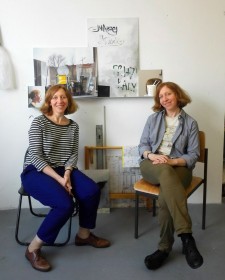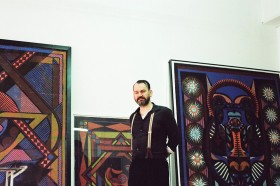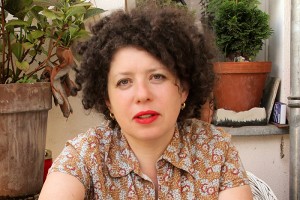A Conversation with the Artists Maria und Natalia Petschatnikov
The end of May, as the first palpable rays of sun shone in Berlin, offered the perfect occasion for an outing to Berlin’s Kreuzberg neighborhood. There the artists Maria and Natalia Petschatnikov showed me their atelier and told me about “Sparrows” and “4 Euros,” the two objects they made for the Jewish Museum Berlin’s art vending machine. They also talked about their current projects and responded with good humor to all of my questions above and beyond the subject of art.

Maria (left) and Natalia Petschatnikov in front of part of their project “Berlin & Berlin”, 2015
© and photo by Michaela Roßberg
Michaela Roßberg: You work together and you’re twins – identical twins. What is it like to work so closely? How do you develop ideas and work on projects? And does one or the other of you start with an image of the finished work in mind?
Maria: We do a lot through dialogue. It isn’t that one of us has an idea and, once a project is finished, could say: “That was my idea.” Our work emerges from a joint process. For instance, we walk through the city and see interesting things that get us thinking. We talk about them, and together, start forming ideas. → continue reading

Georg Sadowicz in his atelier
© Jewish Museum Berlin, photo: Kilian Gärtner
I’m meeting Georg Sadowicz in his atelier in Berlin-Hohenschönhausen. The Berlin-based artist was born in Liegnitz, Poland, on the German border. Since April, two of his pieces – precursors to larger work – have been made available to visitors as a limited run in the Jewish Museum Berlin’s art vending machine. They are titled, “The Cantor” and “The Mill.” Sadowicz’s atelier is a mere hundred meters from the grounds of a former Stasi detention center, now a memorial site. The sight of it troubles me, but the unease vanishes as soon as I step into Sadowicz’s atelier. → continue reading
With her works for our art vending machines, Deborah Wargon exposes things that got swept under the rug

Portrait of Deborah Wargon © Jewish Museum Berlin, photo: Gelia Eisert
A cordial welcome, the wafting flavors of a freshly-cooked meal, a light-drenched room with a high ceiling, full of brightly-colored books and pictures, and a piano with a sign-post ‘to Australia’ sitting on it… My first encounter with Deborah Wargon in her live-in atelier in Berlin’s Prenzlauer Berg neighborhood is a far cry from the rather severe, somber associations that the term ‘testament enforcer’ brings up for me. Wargon – a musician as well as visual and theater artist born in Melbourne in 1962 – describes herself this way on the package insert that comes with the small-scale artworks that she created for the art vending machine in our permanent exhibition. Those artworks bear the title “The Legacy of Friede Traurig” – where Friede Traurig doubles as a proper name and, in German, to mean peace sorrowful. And Deborah Wargon, who is best known for her paper cuttings inside former insect cases, says that she would rather be sorrowful.
With a little good luck, you may get one of her works from the vending machine: for instance, a little human figurine made of rail track ballast (gravel), wire, and newspaper. Aside from the expressive name Friede Traurig, the materials invoke woeful stories of train transports and barbed wire fences, particularly because the newspapers she used are from the Second World War. But for the artist, it’s clearly not only about the specific time the Nazis were in power and the Shoah. It’s also about the legacies, the inheritance, the stories that we all carry with us. She explains her choice of materials: “For me, wire is a fascinating material. It’s also used for cages. So you can use to suggest the ways that we’re all captive.” The rail track gravel, which normally lies on the ground, relates for Wargon to the ground that we all walk on, as descendants of the people who came before us. “Besides, in both German and English there’s the expression ‘to sweep something under the rug’”. The gravel, or grit, that we bring into the house on the soles of our shoes, and then sweep under the rug, stands for something that we don’t want to face and deal with.
→ continue reading


